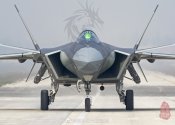plawolf
Lieutenant General
This is an offensive move, not a defensive one. The corkscrew demonstrates incredible nose pointing authority, that means you can save time and energy just pointing your nose at an opponent when they thought they were in a safe and good position to send a missile their way instead of doing it the old fashioned and hard way of beating him ‘fairly’ in a dogfight.But what is the purpose of the corkscrew maneuver? It still can't escape from a missile.
And unlike conventional jets with good nose pointing, the J20 can continue to climb when pointing its nose, meaning it’s not bleeding all of its energy just to get one snapshot attempt.
It’s only looking sluggish at the end due to the continuous corkscrewing and climb while doing so. But in a real fight, it would have loose a missile and returned to normal flight within the first pans or two, meaning minimal airspeed and energy expenditure for a very likely kill and not making itself vulnerable due to ending up in a low energy and airspeed state and needing time to recover.
A typical merge with a J20 would involve the J20 coming in fast, doing a pan, loosing a missile, (optional recovery move to recover some airspeed), do another pan to loose another missile at a (probably) second target, return to normal flight and afterburning out of the merge before the other guy(s) targeted even finished ejecting.

